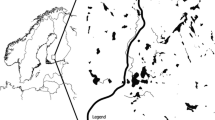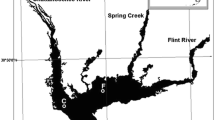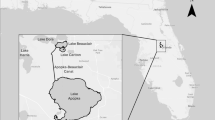Abstract
This study contrasts the effects of human disturbances on two very different lake/catchment systems: Hatch Pond and Beaver Lake, New Hampshire. Hatch is in a steep mountain catchment remote from urban/industrial centers, and is a small, relatively deep, primarily seepage lake with moderate flushing rate. The catchment has been continuously forested, but disturbed by partial loggings and a forest fire. Beaver’s more extensive and gently sloping catchment is much closer to urban/industrial centers, and has been agricultural and recently suburban. Beaver is a larger but shallower drainage lake with much more rapid flushing than Hatch. We compared the sedimentary records and inferred limnological responses to catchment land uses and air pollution inputs of these mesotrophic lakes, and interpreted differing responses as a function of basic differences between the lakes and their catchments. Some chemical and biological variables in the sediment of both lakes respond sensitively to the first disturbances of the catchments by Euro-American settlers. Diatom-inferred Cl at both lakes indicates a modest increase of salinity at this time. Hatch sediment contains a record of soil erosion starting \(\simeq\) 1810 with first logging and fire. For ~125 years, erosion was largely of upper eluviated soil, but by \(\simeq\) 1935 it reached deeper into the illuviated (enriched) horizon. Maximal lake trophic state based on diatom-inferred limnological variables occurred in the mid-1900’s period of maximum sedimentation of illuviated soil. The sediment record since \(\simeq\) 1964 reflects forest maturation, and soil stabilization and acidification, but not lake acidification. At Beaver, the limnological effects of forest clearance and agriculture starting ~1700 were relatively mild due to gentleness of slopes and soil characteristics favoring stability. A near doubling of earth elements, and major increases in trace metal pollutants and coal combustion particles (CCP) occurred in sediment dating around 1900. Landscape analysis as well as historical and sedimentary records preclude the catchment as the major source of these increases. The most likely source is atmospheric fallout of CCP with its metal load. Despite controls on CCP and other emissions starting 1960, concentrations of earth elements and trace metals in Beaver sediment remain high due to soil mobilization by residential development of the catchment. The trophic state of Beaver Lake has increased, but the relative increase has been smaller than at Hatch, despite more intensive land uses and greater aerial inputs at Beaver. We propose that this lesser eutrophication is due to rapid flushing of Beaver Lake with stream water from relatively undeveloped parts of the extensive catchment, and lower sensitivity to nutrient inputs of this naturally more eutrophic lake. A major shift from unicellular to colonial chrysophytes at Hatch starts in the late-1800’s, and at Beaver in the early 1900’s. Colonial taxa in lesser quantities appear at the time of first settlement of the Beaver catchment. At both lakes the shifts are correlated with increasing metal fluxes from the opening of catchment biogeochemical cycles, as with the aforementioned erosional sequence at Hatch. But at Hatch aerial inputs of trace metals, and at Beaver aerial inputs major and trace metals associated with CCP are also correlated with the major chrysophyte shift. It appears that the chrysophytes have responded to stressors associated with both catchment disturbance and regional atmospheric inputs.
Similar content being viewed by others
References
D.S. Anderson R.B. Davis M.S. Ford (1993) ArticleTitleRelationships of sedimented diatom species (Bacillariophyceae) to environmental gradients in dilute northern New England lakes J. Phycol. 29 246–277 Occurrence Handle10.1111/j.0022-3646.1993.00264.x
P.G. Appleby (2001) Chronostratigraphic techniques in recent sediments W.M. Last J.P. Smol (Eds) Tracking Environmental Change Using Lake Sediments NumberInSeriesVol. 1 Kluwer Academic Dordtrecht, The Netherlands 171–203
P.G. Appleby P.J. Nolan D.W. Gifford M.J. Godfrey F.F. Oldfield N.J. Anderson R.W. Batterbee (1986) ArticleTitle210Pb dating by low background gamma counting Hydrobiologia 141 21–27 Occurrence Handle10.1007/BF00026640
P.G. Appleby F. Oldfield (1978) ArticleTitleThe calculation of 210Pb dates assuming a constant rate of supply of unsupported 210Pb to the sediment Catena 5 1–8 Occurrence Handle1:CAS:528:DyaE1MXksVahurw%3D Occurrence Handle10.1016/S0341-8162(78)80002-2
P.G. Appleby N. Richardson P.J. Nolan (1991) ArticleTitle241Am dating of lake sediments Hydrobiologia 214 35–42 Occurrence Handle1:CAS:528:DyaK3MXmtFais7s%3D Occurrence Handle10.1007/BF00050929
P.G. Appleby N. Richardson P.J. Nolan (1992) ArticleTitleSelf-absorption corrections for well-type germanium detectors Nucl. Inst. Meth. B 71 228–233 Occurrence Handle10.1016/0168-583X(92)95328-O
J. Boyle (2004) ArticleTitleA comparison of two methods for estimating the organic matter content of sediments J. Paleolimnol. 31 125–127 Occurrence Handle10.1023/B:JOPL.0000022549.07298.6e
J.P. Bradbury S.M. Coleman R.L. Reynolds (2004) ArticleTitleThe history of recent limnological changes and human impact on Upper Klamath LakeOregon J. Paleolimnol. 31 151–165 Occurrence Handle10.1023/B:JOPL.0000019233.12287.18
J.P. Bradbury J.C.B. Waddington (1973) Stratigraphic record of pollution in Shagawa Lakenortheastern Minnesota H.J.B. Birks R.G. West (Eds) Quaternary Plant Ecology Blackwells Oxford, UK 289–307
R.B. Brugam (1978) ArticleTitleHuman disturbances and the historical development of Linsley Pond Ecology 59 19–36 Occurrence Handle1:CAS:528:DyaE1cXksVylt7Y%3D Occurrence Handle10.2307/1936629
Camburn K.E., Kingston J.C. and Charles D.F. (eds.) 1984–1986. PIRLA diatom iconograph. PIRLA Unpubl. Rpt. Ser., Biol. Dept., Indiana Univ., Bloomington, IN, USA.Rpt. 3: 53 photoplates & 1059 Figs.
D.F. Charles (1990) ArticleTitlePaleoecological investigation of recent lake acidification in the Adirondack Mountains, N.Y. J. Paleolimnol. 3 195–241
Connor J. and O’Loan M. 1993. Beaver Lake Diagnostic/Feasibility Study. New Hampshire Dept. Environmental Services, Concord.Staff Report. 92–15.
W. Cronan (1983) Changes in the Land: Indians, Colonists, and the Ecology of New England Hill & Wang New York 241
B.F. Cumming K.A. Davey J.P. Smol H.J.B. Birks (1994) ArticleTitleWhen did acid-sensitive lakes (New York, USA) begin to acidify and are they still acidifying? Can. J. Fish. Aquat. Sci. 52 1550–1568 Occurrence Handle10.1139/f94-154
Davis R.B. 1976. The Historic and Present Relationships between Phytoplankton and Land Use in Selected Maine Lakes. United States Office of Water Resources Technology, Project A-026-ME Final Report. Maine Land and Water Resource Center, University of Maine, Orono, ME, 38 pp.
Davis R.B., Anderson D.S., Dixit S.S., Schauffler M. and Appleby P.G. 2001. Sediment and Water Column Responses of Beaver LakeNew Hampshire (U.S.A.) to Catchment and Aerial Inputs in Recent Centuries. Report to New Hampshire Department of Environmental Services, Concord, NH, 30 pp.
R.B. Davis D.S. Anderson S.A. Norton J. Ford P.R. Sweets J.S. Kahl (1994b) ArticleTitleSedimented diatoms in northern New England lakes and their use as pH and alkalinity indicators Can. J. Fish. Aquat. Sci. 51 1855–1876
R.B. Davis D.S. Anderson S.A. Norton M.C. Whiting (1994a) ArticleTitleAcidity of twelve New England (U.S.A.) lakes in recent centuries J. Paleolimnol. 12 103–154 Occurrence Handle10.1007/BF00678090
R.B. Davis D.S. Anderson M. Schauffler S.S. Dixit S.C. Landry J.N. Connor (1998) Paleoecological Study of Hatch Pond in Eaton, New Hampshire Interim Report to New Hampshire Department of Environmental Services Concord, NH 38
R.B. Davis D.S. Anderson M.C. Whiting J.P. Smol S.S. Dixit (1990) ArticleTitleAlkalinity and pH of three lakes in northern New England, U.S.A., over the past 300 years Phil. Trans. R. Soc. Lond. B 327 413–421 Occurrence Handle1:CAS:528:DyaK3cXlvFOgsbo%3D
R.B. Davis R.W. Doyle (1969) ArticleTitleA piston corer for upper sediment in lakes Limnol. Oceanogr. 14 643–648
R.B. Davis S.A. Norton (1978a) ArticleTitlePaleolimnological studies of human impact on lakes in the United States, with emphasis on recent research in New England Polskie Archiw. Hydrobiol. 25 99–115
Davis R.B. and Norton S.A. 1978b. Paleolimnology of six New England Lakes. In: New England Council of Water Center Directors (eds.), The Impact of Urbanization on New England Lakes. New England Council of Water Center Directors, Boston, MA, USA, pp. 217–308.
Diers R.W. and Vieira F.J. 1977. Soil Survey of Carroll County, New Hampshire. USSCS & USFS, USDA, 161 pp.
S.S. Dixit J.N. Connor S.C. Landry (2001) ArticleTitlePalaeolimnological study of Willard and Russell Ponds in New Hampshire J. Lake Reserv. Managem. 17 197–216 Occurrence Handle1:CAS:528:DC%2BD38Xit1ans74%3D
S.S. Dixit A.S. Dixit J.P. Smol (1999a) ArticleTitleLake sediment chrysophyte scales from the northeastern U.S.A. and their relationship to environmental variables J. Phycol. 35 903–918 Occurrence Handle10.1046/j.1529-8817.1999.3550903.x
S.S. Dixit A.S. Dixit J.P. Smol R.M. Hughes S.G. Paulsen (2000) ArticleTitleWater quality changes from human activities in three northeastern USA lakes Lake Reserv. Manage. 16 305–321 Occurrence Handle1:CAS:528:DC%2BD3MXkvFWhuw%3D%3D Occurrence Handle10.1080/07438140009354238
S.S. Dixit J.P. Smol D.F. Charles R.M. Hughes S.G. Paulsen G.B. Collins (1999b) ArticleTitleAssessing water quality changes in the lakes of the northeastern United States using sediment diatoms Can. J. Fish. Aquat. Sci. 56 131–152 Occurrence Handle10.1139/cjfas-56-1-131
C.T. Driscoll G. Likens L.O. Hedin J.S. Eaton F.H. Bormann (1989) ArticleTitleChanges in the chemistry of surface waters: 25-year results at the Hubbard Brook Experimental Forest, New Hampshire Envir. Sci. Technol. 23 137–143 Occurrence Handle1:CAS:528:DyaL1MXhtVWhtrg%3D Occurrence Handle10.1021/es00179a001
D.R. Engstrom E.B. Swain J.L. Kingston (1985) ArticleTitleA paleolimnological record of human disturbance from Harvey’s LakeVermont: geochemistry, pigments and diatoms Freshw. Biol. 15 261–288 Occurrence Handle1:CAS:528:DyaL2MXltV2lsbk%3D Occurrence Handle10.1111/j.1365-2427.1985.tb00200.x
R.H. Estabrook S.T. Ashley W.M. Henderson SuffixJr. (2002) New Hampshire Lakes and Ponds Inventory NumberInSeriesVol. 17 New Hampshire Department of Environmental Services Concord, NH 277
I.J. Fernandez R.A. Rustad S.A. Norton J.S. Kahl D.J. Cosby (2003) ArticleTitleExperimental acidification causes soil base cation depletion in a New England forested watershed Soil Sci. Soc. Am. J. 17 1909–1919 Occurrence Handle10.2136/sssaj2003.1909
E.T. Furlong L.R. Cessar R.S. Hites (1987) ArticleTitleAccumulation of polycyclic aromatic hydrocarbons in acid sensitive lakes Geochim. Cosmochim. Acta 51 2965–2975 Occurrence Handle1:CAS:528:DyaL1cXis1OitQ%3D%3D Occurrence Handle10.1016/0016-7037(87)90370-X
P.J. Garrison S.A. Fitzgerald (2005) ArticleTitleThe role of shoreland development and commercial cranberry farming in a lake in Wisconsin, USA J. Paleolimnol. 33 169–188 Occurrence Handle10.1007/s10933-004-3990-4
G.D. Gephart (1985) Surficial Geologic Map of the Derry Quadrangle, Rockingham County, New Hampshire N.H. Dept Resources and Economic Development and U.S. Geological Survey, COGEOMAP Program Concord, N.H. map
N. Henney K. Henney (1967) The Early Days of Eaton Reporter Press N. Conway, NH 107
N. Henney K. Henney (1972) Eaton Records Reporter Press N. Conway, NH 203
E.E. Hoover (1937) Biological Survey of the Androscoggin, Sacoand Coastal Watersheds New Hampshire Fish and Game Dept Concord N.H 160
E.E. Hoover (1938) Biological Survey of the Merrimack Watershed New Hampshire Fish and Game Dept Concord N.H 238
D.H. Hurd (1882) History of Rockingham and Strafford Counties, New Hampshire J.W. Lewis Philadelphia 888
InstitutionalAuthorNameHurd C.H. & Co. (1892) Town and City Atlas of the State of New Hampshire C.H. Hurd & Co Boston 34
G.E. Hutchinson (1970) ArticleTitleIanula: an account of the history and development of the Lago di MonterosiLatiumItaly Trans. Am. Phil. Soc., New Ser. 60 IssueIDpart 4 1–178 Occurrence Handle10.2307/1005996
R.J. Kelsea J.P. Gove (1994) Soil Survey of Rockingham County, New Hampshire Soil Conservation Service, U.S. Dept. Agriculture Washington, DC 47
R.G. Kreis SuffixJr. (1989) Variability study B interim results D.F. Charles D.R. Whitehead (Eds) Paleoecological Investigation of Recent Lake Acidification (PIRLA): 1983–1985 Electric Power Research Institute Palo Alto, CA 4-1–4-48
P.R. Leavitt D.L. Findlay R.J. Hall J.P. Smol (1999) ArticleTitleAlgal responses to dissolved organic carbon loss and pH decline during whole-lake acidification: evidence from paleolimnology Limnol. Oceanogr. 44 757–773 Occurrence Handle1:CAS:528:DyaK1MXjs1Oqtbs%3D Occurrence Handle10.4319/lo.1999.44.3_part_2.0757
G.E. Likens (1992) The Ecosystem Approach: Its Use and Abuse. Excellence in Ecology Vol. 3 (O. Kinneed.) Ecology Institute Oldendorf/LuheGermany 166
G.E. Likens C.T. Driscoll D.C. Buso (1996) ArticleTitleLong-term effects of acid rain: response and recovery of a forest ecosystem Science 272 244–246 Occurrence Handle1:CAS:528:DyaK28Xit1Kqs7g%3D
F.J.H. Mackereth (1966) ArticleTitleSome chemical observations on post-glacial lake sediments Phil. Trans. Roy. Soc. Lond., Ser. B. 250 165–213 Occurrence Handle1:CAS:528:DyaF28XktVeisLk%3D
L.J. Marsicano P.A. Siver (1993) ArticleTitleA paleolimnological assessment of lake acidification in five Connecticut lakes J. Paleolimnol. 9 209–221 Occurrence Handle10.1007/BF00677214
M.V. Melosi (1980) Pollution and Reform in American Cities, 1870–1930 University of Texas Press Austin 212
G.D. Merrill (Eds) (1889) History of Carroll County, New Hampshire W.A. Fergusson & Co Boston 987
J.O. Miettinen H. Simola E. Grönlund J. Lahtinen R. Niinioja (2005) ArticleTitleLimnological effects of growth and cessation of agricultural land use in Ladoga Karelia: sedimentary pollen and diatom analyses J. Paleolimnol. 34 229–243 Occurrence Handle10.1007/s10933-005-2542-x
A.E. Newall (1970) Biological Survey of the Lakes and Ponds in Cheshire, Hillsborough and Rockingham Counties New Hampshire Fish and Game Department, Survey Rpt. 8c Concord, NH 219
A.E. Newall (1972) Biological Survey of the Lakes and Ponds in Coos, Grafton and Carroll Counties New Hampshire Fish and Game Department, Survey Rpt. 8a Concord, NH 297
New Hampshire Water Supply and Pollution Control Division 1990. New Hampshire Lakes and Pond Inventory, Vol. VI. Staff Rpt 90–3, pp. 148–153 (Hatch Pond).
R.M. Newton (1974) Surficial Geology of the Ossipee Lake Quadrangle, New Hampshire New Hampshire Department of Resources and Economic Development Concord, NH Bull. 3 52
K.H. Nicholls (1995) Chrysophyte blooms in the plankton and neuston of marine and freshwater systems C.D. Sandgren (Eds) et al. Chrysophyte Algae: Ecology, Physiology, and Development Cambridge University Press Cambridge, U.K 181–213
S.A. Norton R.W. Bienert SuffixJr. M.W. Binford J.S. Kahl (1992) ArticleTitleStratigraphy of total metals in PIRLA sediment cores J. Paleolimnol. 7 191–214 Occurrence Handle10.1007/BF00181714
S.A. Norton P.J. Dillon R.D. Evans G. Mierle J.S. Kahl (1990) The history of atmospheric deposition of CdHg, and Pb in North America: evidence from lake and peat bog sediments S.E. Lindberg (Eds) et al. Acidic Deposition B Sources, Deposition, and Canopy Interactions NumberInSeriesVol. III Springer-Verlag NY 73–102
J.F. O’Keefe D.R. Foster (1998) Ecological history of Massachusetts forests C.H.W. Foster (Eds) Stepping Back to Look Forward Harvard University Harvard Forest 19–66
A.M. Paterson B.F. Cumming J.P. Smol J.M. Blais R.L. France (1998) ArticleTitleAssessment of the effects of logging, forest fires, and drought on lakes in northwestern Ontario: a 30-year paleolimnological perspective Can. J. For. Res. 28 1546–1556 Occurrence Handle10.1139/cjfr-28-10-1546
A.M. Paterson B.F. Cumming J.P. Smol R.I. Hall (2004) ArticleTitleMarked recent increases of colonial scaled chrysophytes in boreal lakes: implications for the management of taste and odour events Freshw. Biol. 49 199–207 Occurrence Handle10.1046/j.1365-2427.2003.01170.x
J.M. Ramstack S.C. Fritz D.R. Engstrom S.A. Heiskary (2003) ArticleTitleThe application of a diatom-based transfer function to evaluate regional water-quality trends in Minnesota since 1970 J. Paleolimnol. 29 79–94 Occurrence Handle10.1023/A:1022869205291
N.L. Rose (1990) ArticleTitleA method for selective removal of inorganic ash particles from lake sediments J. Paleolimnol. 4 61–67 Occurrence Handle10.1007/BF00208299
E.W.B. Russell R.B. Davis R.S. Anderson T.E. Rhodes D.S. Anderson (1993) ArticleTitleRecent centuries of vegetational change in the glaciated north-eastern United States J. Ecol. 81 647–664 Occurrence Handle10.2307/2261663
InstitutionalAuthorNameSaco Valley Printing (1982) The Old Maps of Carroll County, New Hampshirein 1892 Saco Valley Printing Fryeburg, ME 37
S.H. Schurr B.C. Netschert (1960) Energy in the American Economy, 1850–1975; An Economic Study of its History and Prospects Johns Hopkins Press Baltimore 774
P.A. Siver (1987) ArticleTitleThe distribution and variation of Synura species (Chrysophyceae) in Connecticut, U.S.A Nord. J. Bot. 7 107–116
P.A. Siver (1993) ArticleTitleInferring the specific conductivity of lake water with scaled chrysophytes Limnol. Oceanogr. 38 1480–1492 Occurrence Handle1:CAS:528:DyaK2cXit1Kjs7c%3D Occurrence Handle10.4319/lo.1993.38.7.1480
P.S. Siver A.M. Lott (2000) ArticleTitlePreliminary investigation on the distribution of scaled chrysophytes in Vermont and New Hampshire (U.S.A.) lakes and their utility to infer lake water chemistry Nord. J. Bot. 20 233–246
P.A. Siver R. Ricard R. Goodwin A.E. Giblin (2003) ArticleTitleEstimating historical in-lake alkalinity generation from sulfate reduction and its relationship to lake chemistry as inferred from algal microfossils J. Paleolimn. 29 179–197 Occurrence Handle10.1023/A:1023246321517
J.P. Smol (2002) Pollution of Lakes and Rivers: A Paleoenvironmental Perspective Arnold Publishers London 230
L.D. Smoot (1991) Coal and char combustion W. Bartok A.F. Sarofim (Eds) Fossil Fuel Combustion, A Source Book J. Wiley & Sons NY 653–781
A. Spiramadas (1966) The Geology of the Manchester Quadrangle, New Hampshire New Hampshire Department of Resources and Economic Development Concord, New Hampshire
D. Stradling (1999) Smokestacks and Progressives Johns Hopkins Press Baltimore 270
J.G. Stockner W.W. Benson (1967) ArticleTitleThe succession of diatom assemblages in the recent sediments of Lake Washington Limnol. Oceanogr. 12 513–532 Occurrence Handle10.4319/lo.1967.12.3.0513
USEPA (United States Environmental Protection Agency). 1994. Microwave Assisted Acid Digestion of Sediments, Sludges, Soils, and Oils. Method 3051.
USEPA (United States Environmental Protection Agency). 1995. National Air Pollutant Emission Trends, 1900–1995. USEPA Rpt EP4.24:995, Washington, DC, 74 pp.
USEPA (United States Environmental Protection Agency). 1996. ICP Method 200.7 CLP-M. The U.S. EPA Contract Laboratory ProgramStatement of Work for Inorganics Analysis, Doc. #ILM04.0, EPA/540/R95/121. (ICP SOP, Rev. #2, 8/96).
R.A. Vollenweider (1979) ArticleTitleDas Nährstoffbelastungskonzept als Grundlage für den externen Eingriff in den Eutrophierungsprozess stehender Gewasser und Talsperren Z. Wass. Abwass.-Forsch. 12 46–56 Occurrence Handle1:CAS:528:DyaE1MXks1agurY%3D
H.F. Walling (1861) Topographical Map of Carroll County Smith & Peavey Pearl St., NY
S.B. Watson T. Satchwill E. Dixon E. McCauley (2001) ArticleTitleUnder-ice blooms and source-water odour in a nutrient-poor reservoir: biological, ecological and applied perspectives Freshw. Biol. 46 1–15 Occurrence Handle1:STN:280:DC%2BD3M3jsVOhuw%3D%3D Occurrence Handle10.1046/j.1365-2427.2001.00769.x
R.G. Wetzel (1999) Limnology Morgan Kaufmann Publ San Francisco 1006
G.G. Whitney (1994) From Coastal Wilderness to Fruited Plain: A History of Environmental Change in Temperate North America from 1500 to the Present Cambridge University Press Cambridge, England 451
G.F. Willey (1895) Willey’s Book of Nutfield G.F. Willey Publ Derry Depot, New Hampshire 367
J.R. Wilson (1969) The Geology of the Ossipee Lake Quadrangle, New Hampshire New Hampshire Dept. Resources & Economic Development Concord, N.H 116
Author information
Authors and Affiliations
Corresponding author
Rights and permissions
About this article
Cite this article
Davis, R.B., Anderson, D.S., Dixit, S.S. et al. Responses of Two New Hampshire (USA) Lakes to Human Impacts in Recent Centuries. J Paleolimnol 35, 669–697 (2006). https://doi.org/10.1007/s10933-005-4505-7
Received:
Accepted:
Issue Date:
DOI: https://doi.org/10.1007/s10933-005-4505-7




